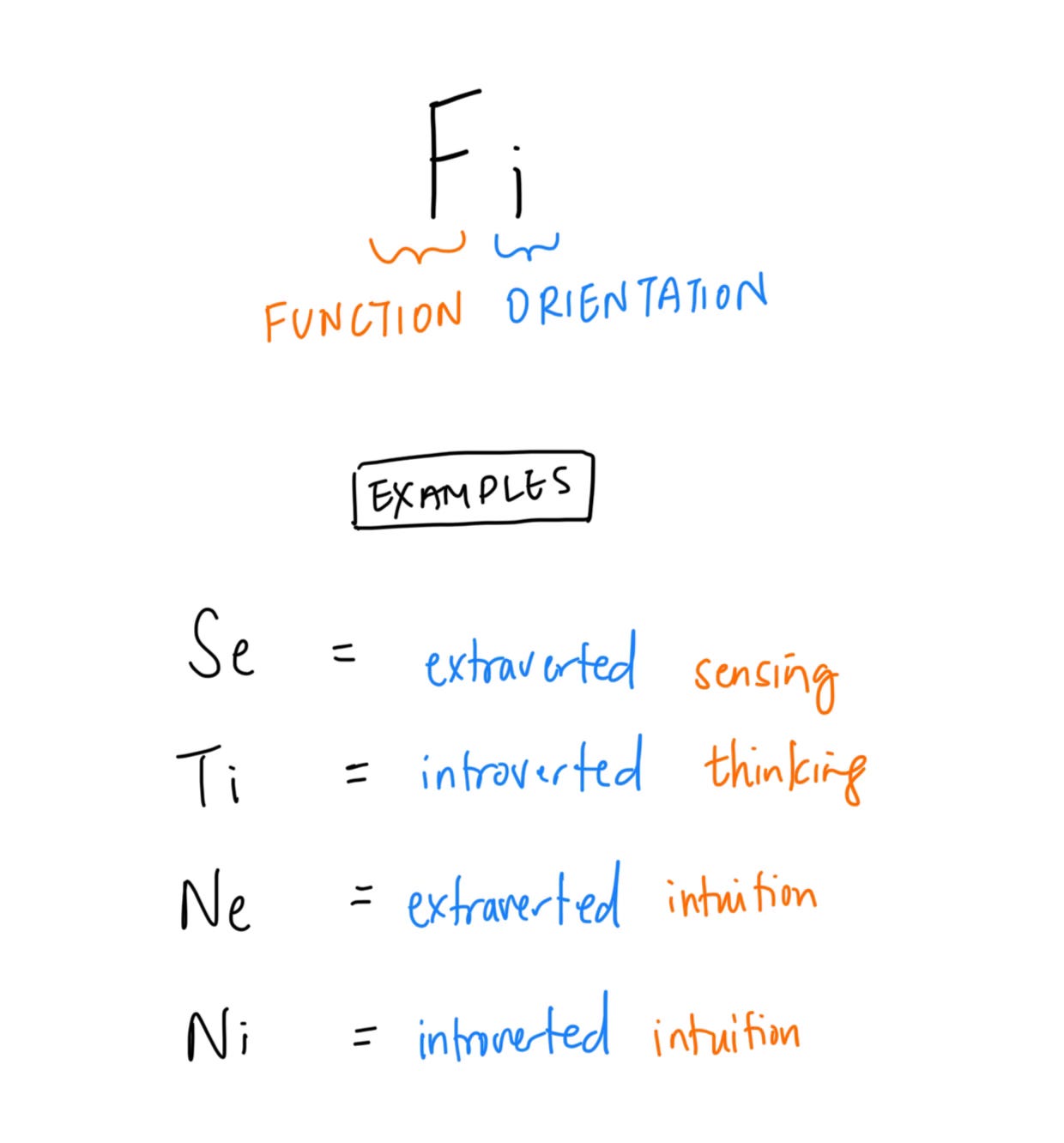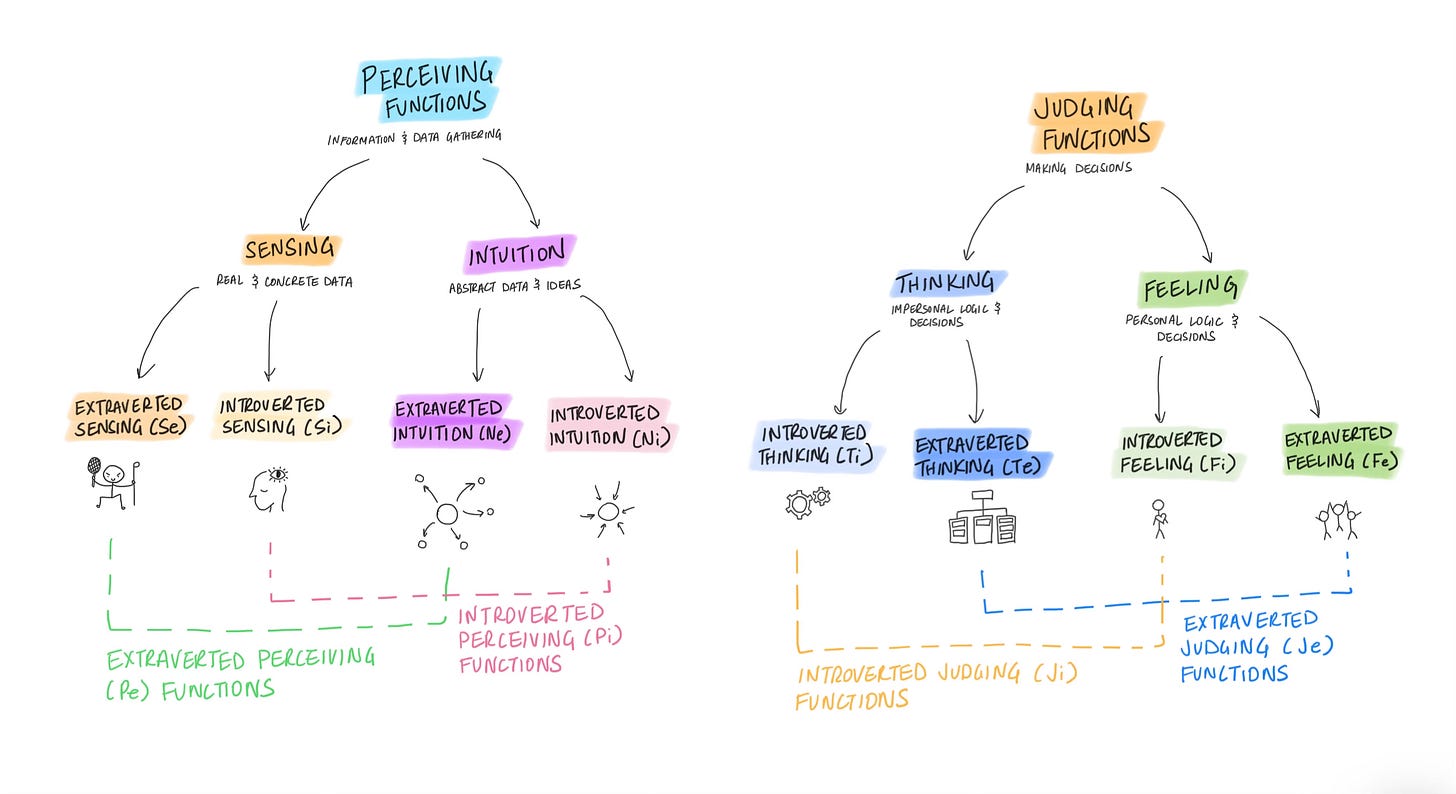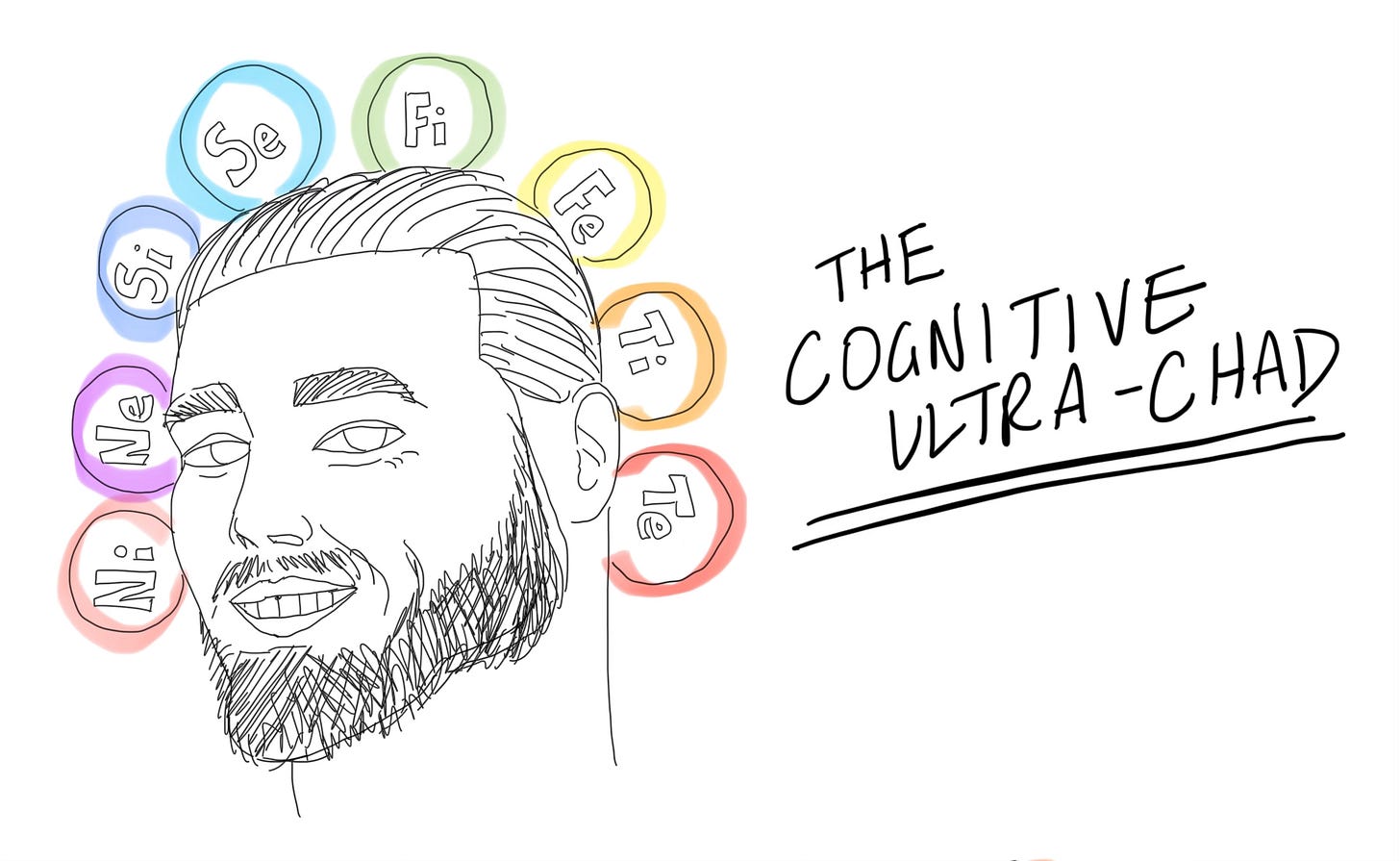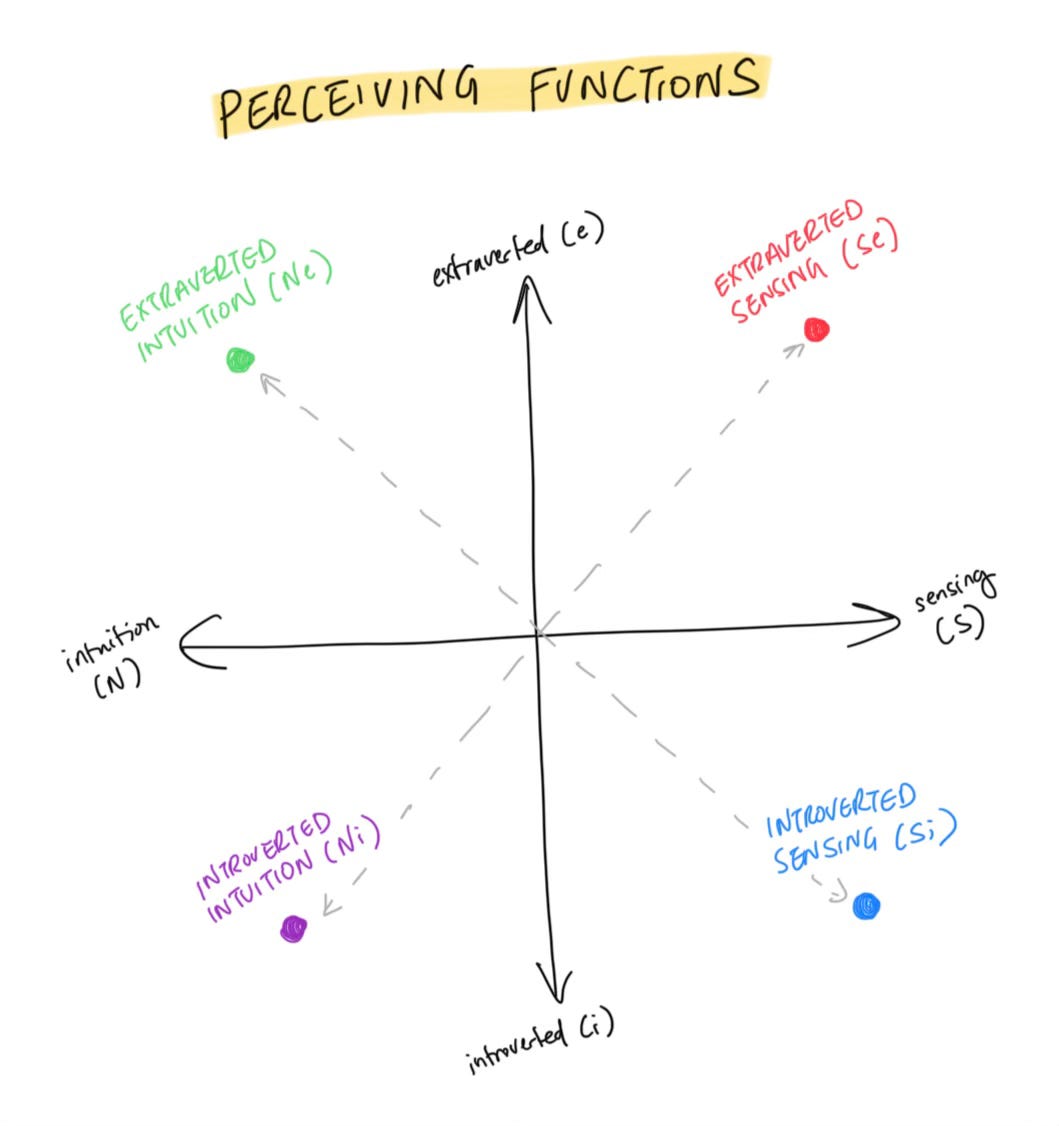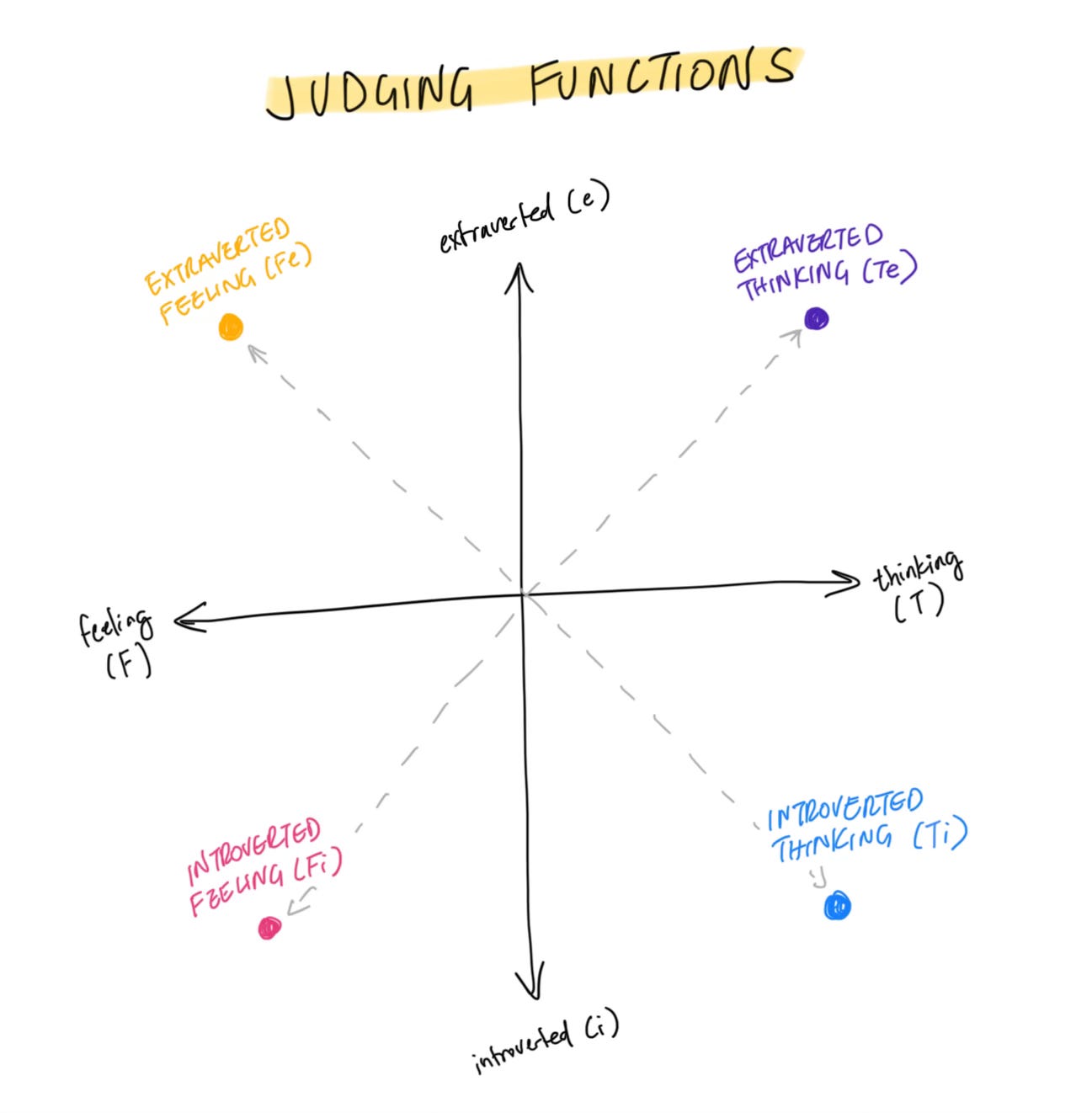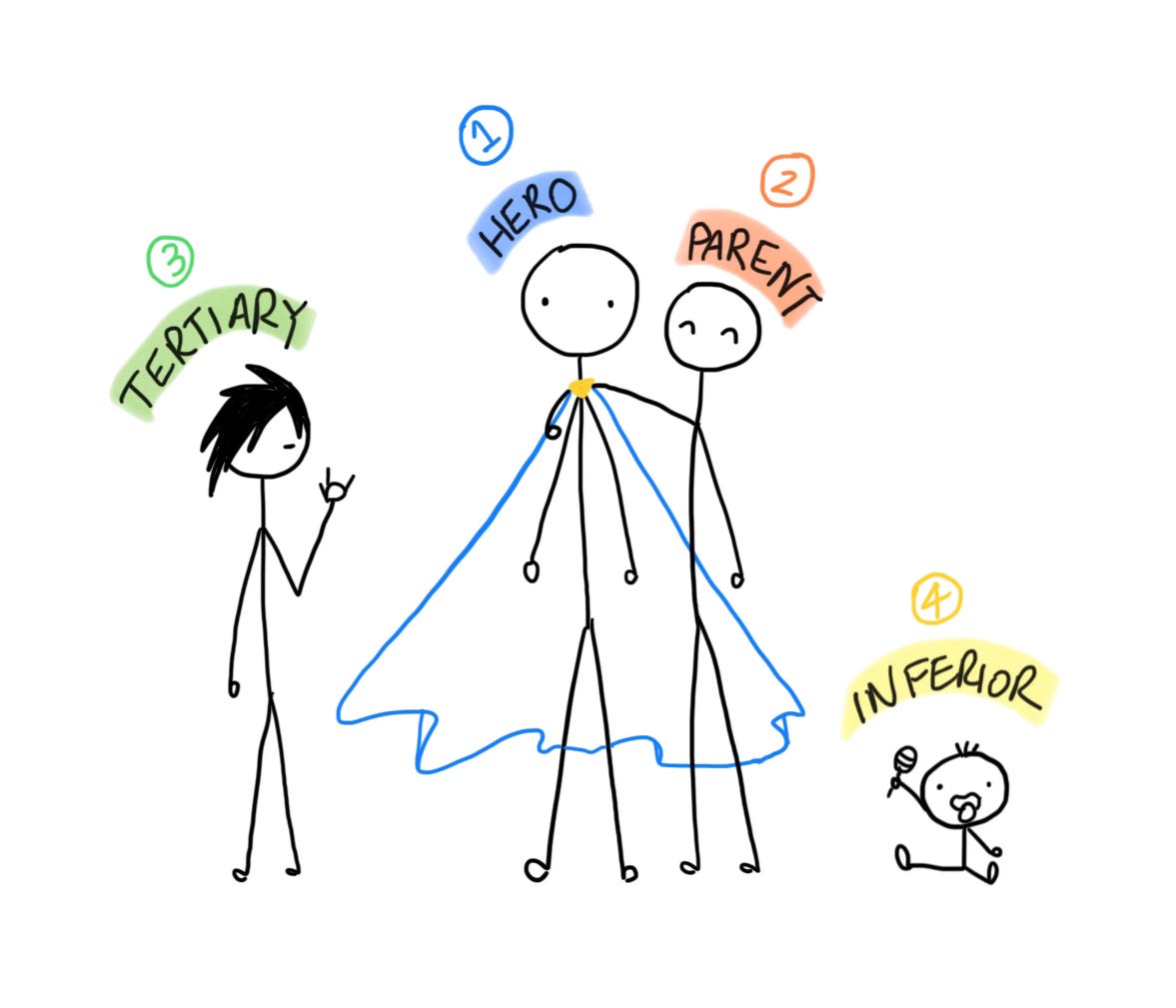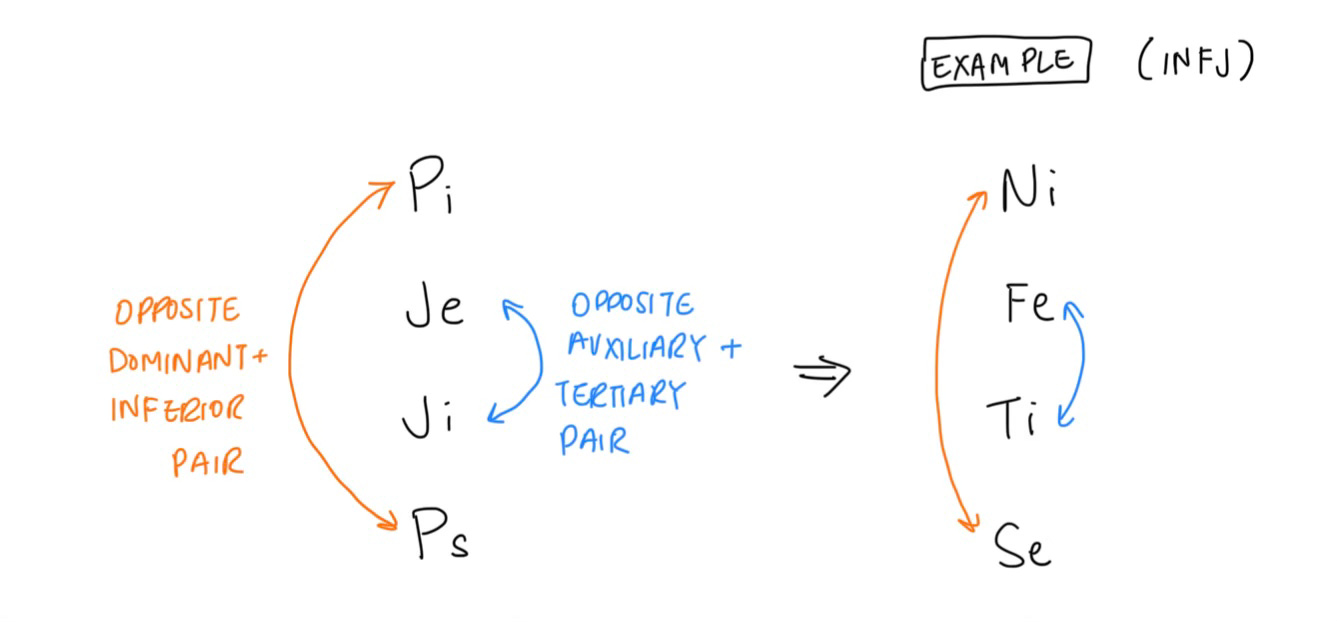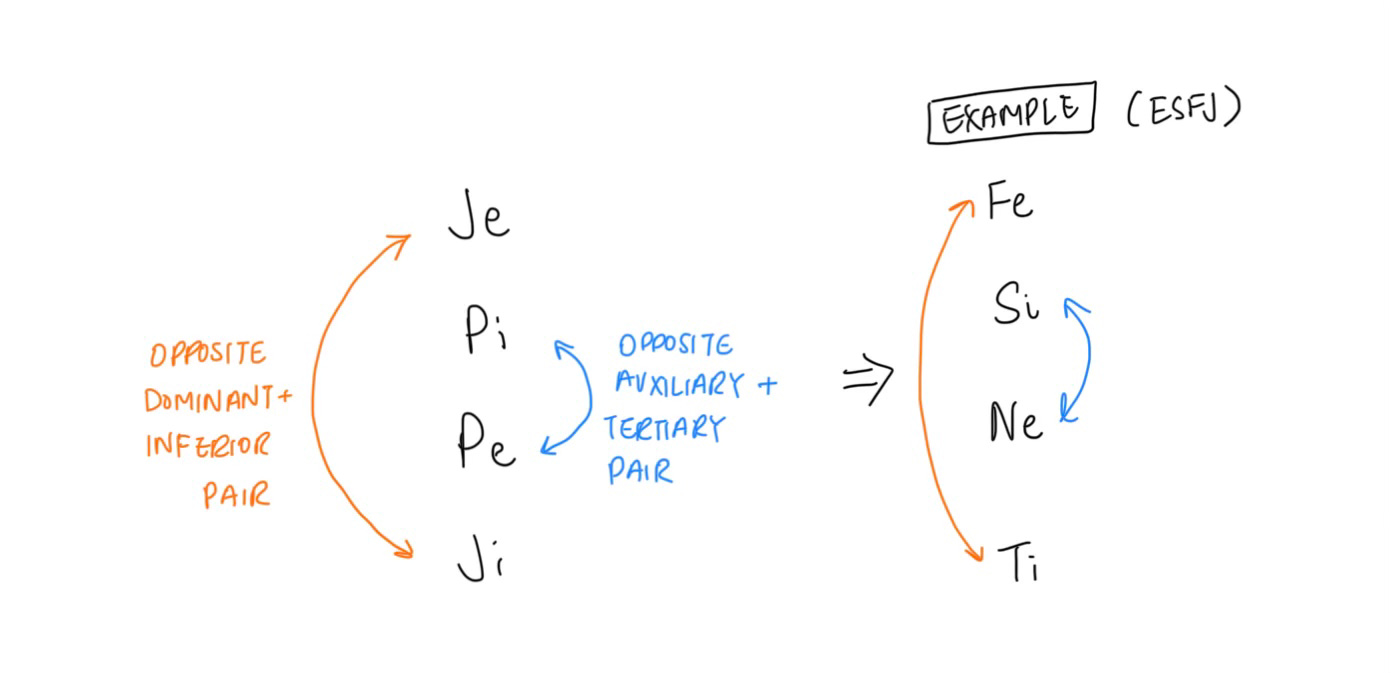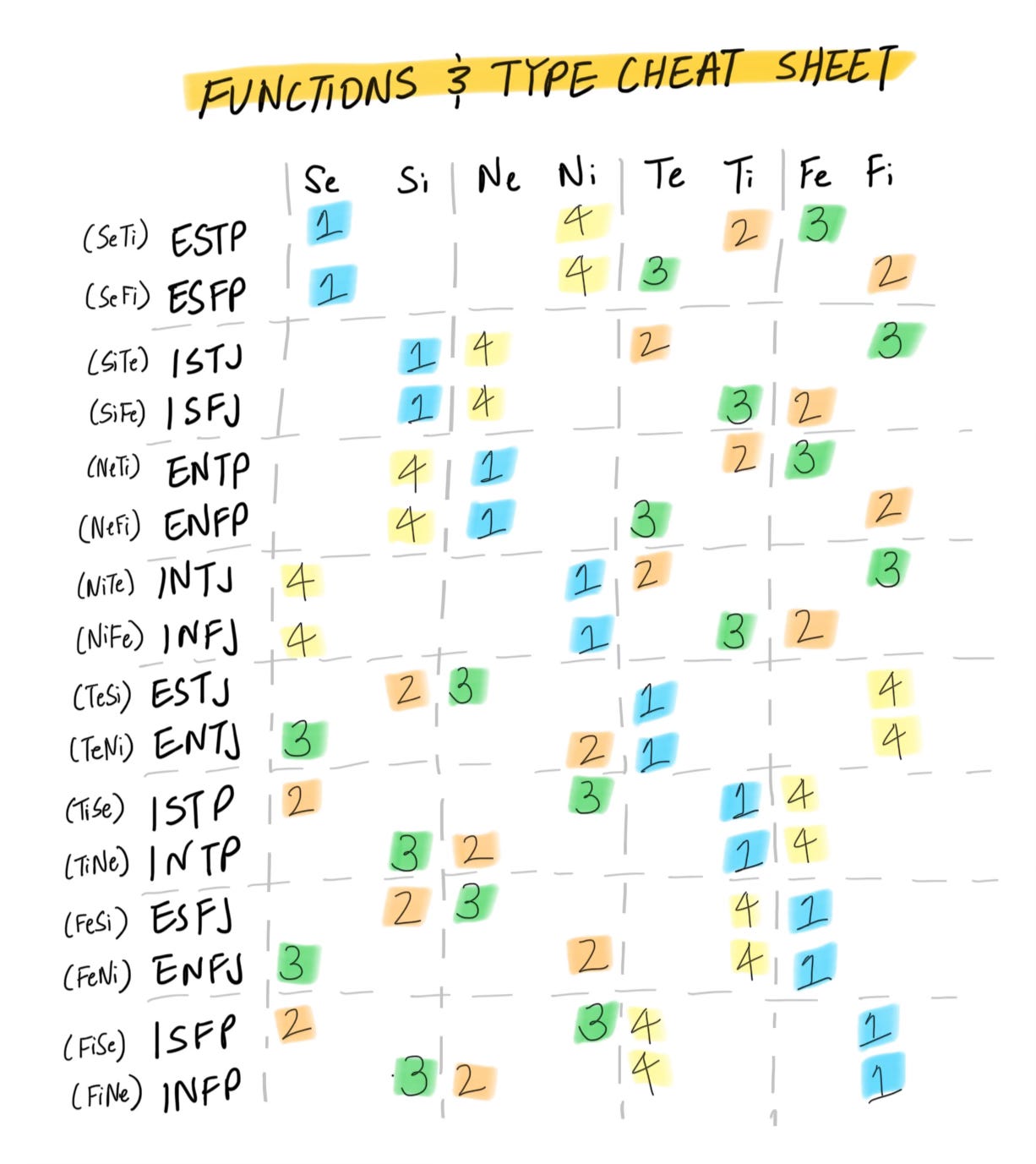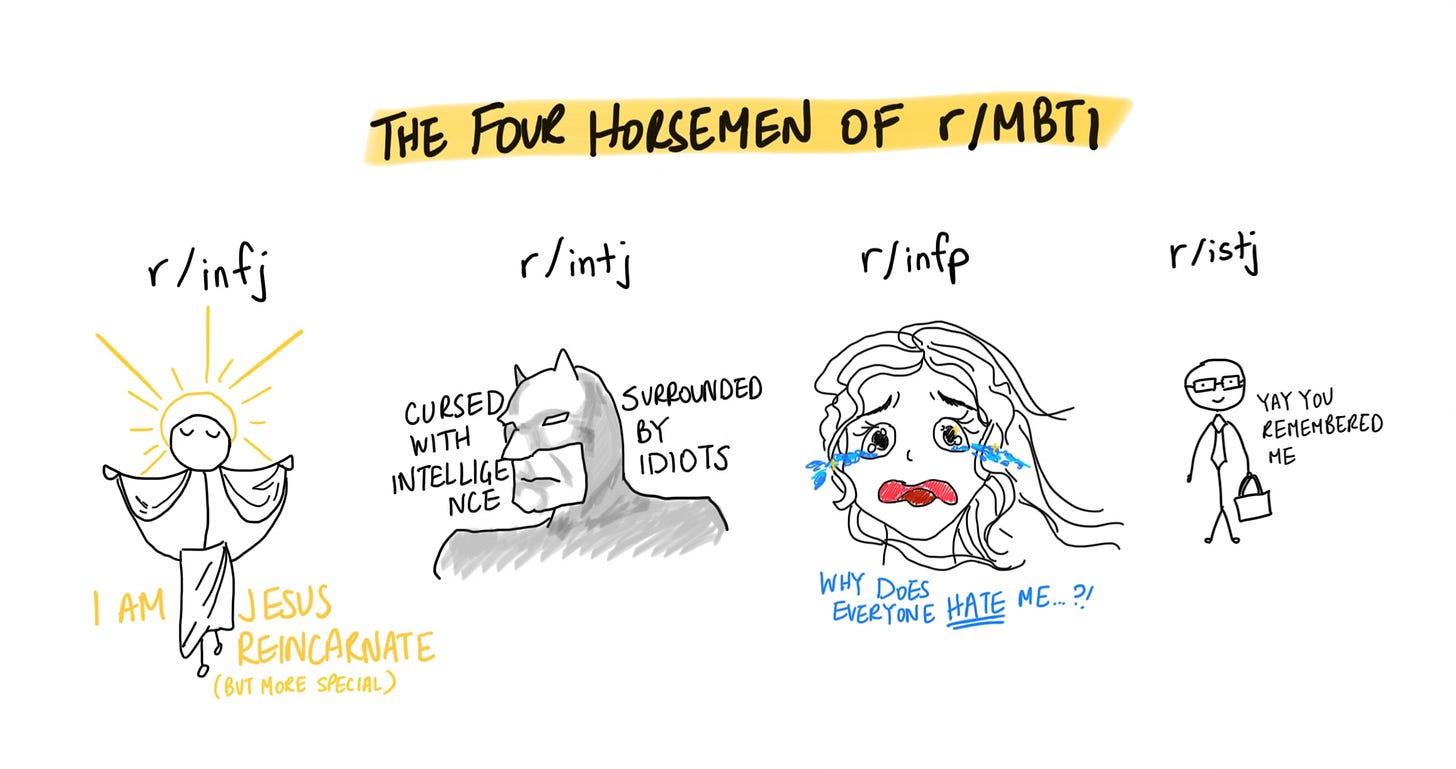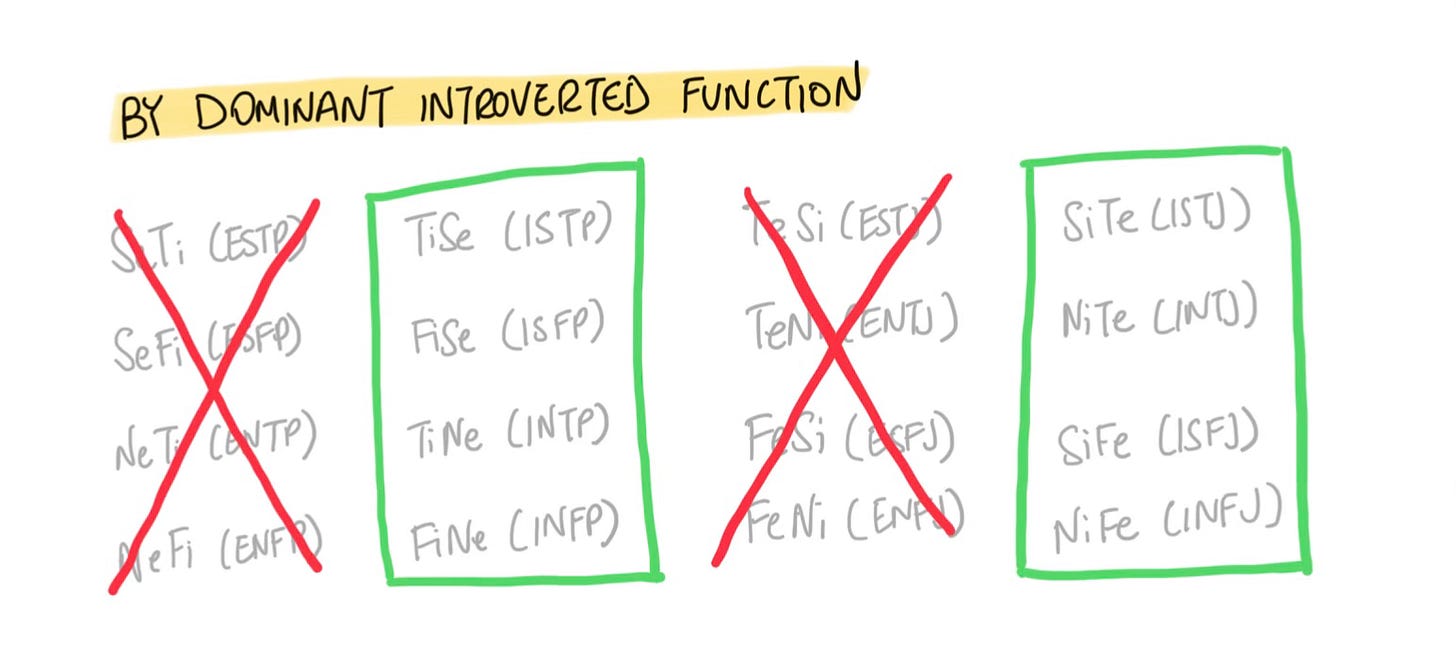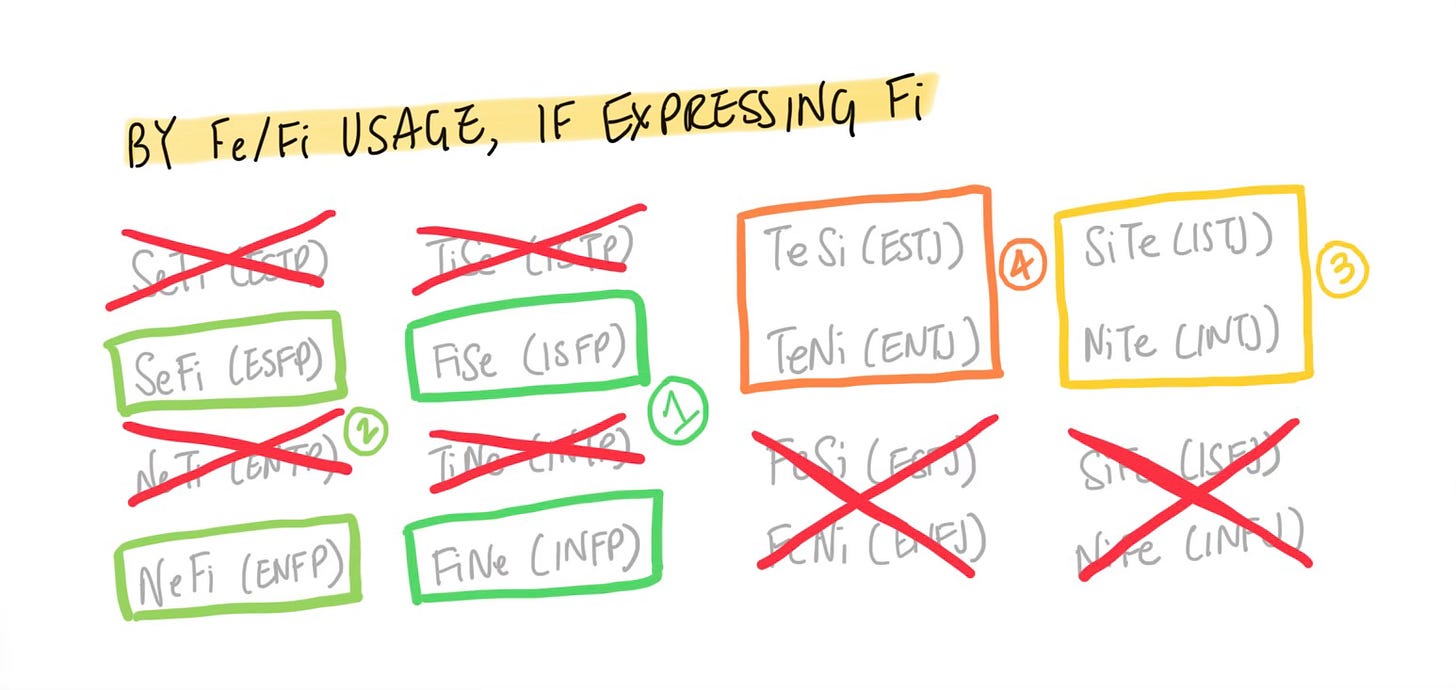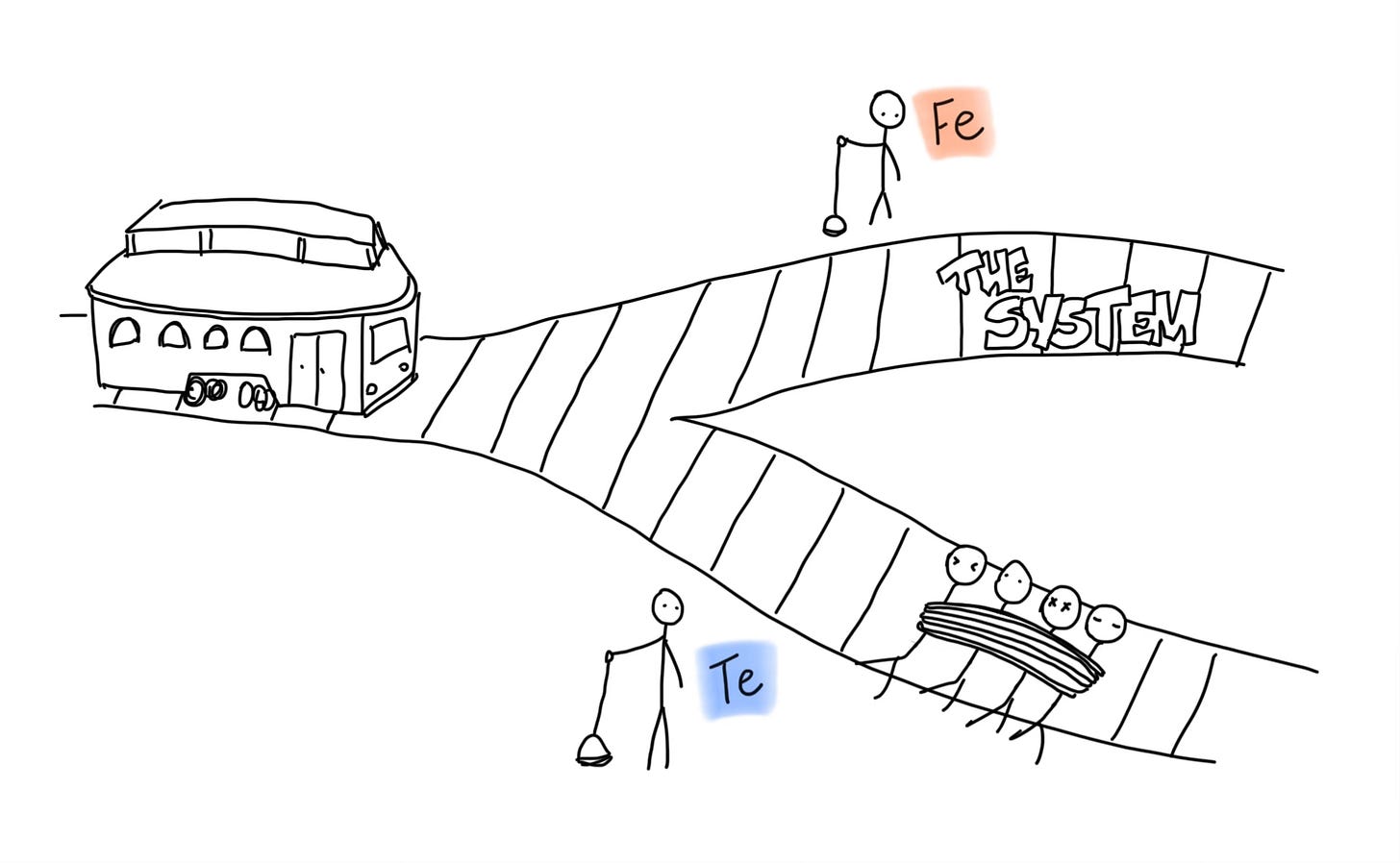How to type yourself using MBTI cognitive functions
Myers-Briggs theory made easy (or at least with fun diagrams)
Outline
Author’s notes
At nearly 8k words, this is a lengthy dive into MBTI theory. To ease skimming, I’ve bolded important concepts. This guide also doesn’t have to be read in order; you can use the outline above to skip around to sections.
Additionally, as this post is theory-heavy, I give examples in each section to help ground it. For better parsing, I use 🔍 to indicate that an example is coming up.
An introduction to MBTI
MBTI, or Myers-Briggs Type Indicator, is a cognitive typology system based on the works and theory of Carl Jung and expanded upon by duo Katherine Briggs and Isabel Myers. MBTI exploded in popularity post-WWII and is used anywhere from corporate to personal development.
Why type yourself? Personal development is a life-long journey, and personality typing is great for self-reflection, growth, and understanding others. By giving you a system to map your mental models and language to describe them, the MBTI, which has been around for 80 years, gives you a way to know yourself. Plus, it’s a fun system to discuss with friends!
The best way to identify your MBTI type is to combine the hard work of self-reflection with an understanding of MBTI theory. Most people interested in MBTI tend to take the 16personalities test and stop there. While there’s nothing wrong with that for the layperson, tests tend to mistype and muddy the waters with other assessments (ex. 16personalities is a NERIS test and tends to mistype MBTI). The other problem with tests is that MBTI uses cognition to inform and understand behaviour, not the other way around. A lot of tests inverse the order, because cognition is hard to evaluate and behaviour is easier. This is also why tests can be maddeningly stereotype-laden: all high school cheerleaders are ESFPs, all sensitive poets are INFPs, routine-following nerds are ISTJs, etc.
That being said, I don’t think tests are a bad way to start – they give you directional guidance. However, once you start augmenting tests with theory, your typing gets sharper and it’s more understandable why mistypes happen. For example, an understanding of theory can explain why someone who typed as INFP (FiNeSiTe) on 16personalities is actually an ESFP (SeFiTeNi) – the presence of Fi can feel very strong to the ESFP, who holds their internal system dear to their heart, causing this to emphasize on tests while disregarding their leading Se function, which is as natural as breathing air.
If you’re interested in MBTI theory and using cognitive functions to type but don’t know where to start, this guide is for you. The goals here are to:
Introduce MBTI theory in an approachable way
Share MBTI theory resources that you can reference
Explain some of the harder-to-understand theory sections with specific examples
Help you type yourself using the theory you just learned
This guide is written to be user-friendly when read in order, so if you’re new, continue to the next section. If you’re familiar with concepts, feel free to skip around. Let’s get started!
Cognitive functions
Carl Jung, the father of modern-day MBTI, laid out 8 cognitive functions in his book Psychological Types. Cognitive functions are processes for understanding and interacting with our world and ourselves. They guide how we perceive our external realities, our internal systems, what factors are most important in decisions, and where our weaknesses may lie.
All types use all eight cognitive functions, as they’re more or less so all critical to survival. Like all skills though, we naturally favour or develop some, leading them to become our dominant choice of functions, and by doing so trade off developing others, which become weaker.
In generally accepted MBTI typology, our top 4 cognitive functions are considered our “conscious” stack, and our weakest 4 are considered “subconscious” or our “shadow” stack. Our top 4 functions and the order in which they appear result in our MBTI type. To start, let’s understand each cognitive function as a standalone building block.
Function and orientation
There are four basic cognitive functions: Sensing (S), Intuition (N), Thinking (T), and Feeling (F). Because these are the same letters that are used in commonplace MBTI tests, they should be familiar.
Sensing (S) and Intuition (N) are both Perceiving functions, or what Jung called irrational. “Irrational” here doesn’t mean “unreasonable” or “illogical”; rather, perceiving functions gather information and data without judgement, ranging from the texture of grilled tofu on the tongue to the expression on your mother’s face when you told her you failed a math test. Sensing focuses on processing real and concrete data, which is why it’s often associated with the five senses and physical observation. Intuition focuses on processing abstract data, which is why it’s often associated with exploring patterns, associations, and systems that are one layer removed from concrete reality.
Thinking (T) and Feeling (F) are Judging functions, or what Jung called rational, and they impact how we make decisions. They influence whether and how you confront your friend on a series of actions that hurt you, or how you should price the lawn chair you want to sell. Thinking focuses on impersonal decisions. By impersonal, I don’t mean that using Thinking functions makes you a dick. Thinking orients you to make judgements and decisions with non-personal factors in mind: the systems of objects and processes. Feeling focuses on personal decisions, which similarly doesn’t mean it is by default warm or empathetic. Feeling orients you to make decisions with inter- and intra-personal factors in mind: morality, value, harmony, conflict.
Each function has either an inward bent or an outward bent. This separation creates the eight cognitive functions. You will generally see them denoted with a two-letter symbol, ex. Fi, the former of which represents the function, and the latter of which represents the attitude or orientation. Sensing can be separated into extraverted Sensing (Se) and introverted Sensing (Si), Intuition into extraverted Intuition (Ne) and introverted Intuition (Ni), and so on.
Extraverted and introverted here doesn’t refer to social extraversion and introversion. When applied to cognitive functions, it refers to whether the function is focused on the objective (external) world or the subjective (internal) world. An objective or external bent focuses the function’s attention on the world outside of oneself: physical reality, social structures, rules and regulations, etc. A subjective or internal bent focuses the function’s attention on one’s internal realm: individual morality, memory, personal systems of logic and interpretation, etc.
🔍 As an example, Feeling is generally concerned with values, morality, emotions, and the personal, especially when it comes to making decisions. Extraverted Feeling (Fe) is typically more focused on external expressions of the above – like social structure, group cohesion and harmony, community values, and interpersonal communication. Introverted Feeling (Fi) is typically more focused on internal expressions of the above – like personal moral systems, authenticity and identity, and intrapersonal analysis.
🔍 Sensing is generally associated with physical reality, concrete events and items, sensations, and awareness. Extraverted Sensing (Se) is typically focused on external expressions of the above, and is generally highly responsive and attentive to the details and happenings of the present, like noticing how light filters through a window. Introverted Sensing (Si) is associated with interpreting those senses through memory and subjective sensation, like remembering how the morning light spilled through your south-facing childhood bedroom while your mom made breakfast downstairs.
So, to recap, there are 4 cognitive functions – Sensing (S), Intuition (N), Thinking (T), and Feeling (F), 2 of which are Perceiving (P) functions related to information intake (S and N), and 2 of which are Judging (J) functions related to decision making (T and F). Each function has either an introverted or extraverted bent, resulting in 8 total cognitive functions: Se, Si, Ne, Ni, Te, Ti, Fe, Fi. They can be viewed as:
2 extraverted Perceiving (Pe) functions: Se, Ne
2 introverted Perceiving (Pi) functions: Si, Ni
2 extraverted Judging functions (Je): Te, Fe
2 introverted Judging functions (Ji): Ti, Fi
It’s useful to read descriptions of cognitive functions for type spotting, so I’ve gathered a few links that describe them. These resources focus on each cognitive function in a silo so you can better understand them individually:
Personality Junkie’s The 8 Functions
Funky MBTI Fiction’s Cognitive Functions
Psychology Junkie’s Comprehensive Guide to the Cognitive Functions
MBTI Notes’s Type Concepts At a Glance
Carl Jung’s Psychological Types – it’s never bad to read source material, but as with all older writing it can be a bit hard to parse and not as directly connected to typing as reading interpretations can be. Your local library should have this.
And here are my own associations of each function when expressed in a type that uses it high in their stack:
Extraverted Sensing (Se): the present, awareness, sensory intake, kinesthetic learning, an appetite for risk
Introverted Sensing (Si): filtered and personal sensation, memory, detail, a healthy respect for established and proven processes
Extraverted Intuition (Ne): excitement for possibilities, innovation and creativity, a change agent, idea jumps
Introverted Intuition (Ni): goal orientation, meta-perception, future speculation and implications, cohesive narratives
Extraverted Thinking (Te): efficiency and productivity, object and system organization, an interest in competence, empirical, responsibility
Introverted Thinking (Ti): ground-up logic, independent assessment and analysis, interested in discerning truth
Extraverted Feeling (Fe): people organization, community and cultural morality, interpersonal care and empathy, interpersonal responsibility
Introverted Feeling (Fi): personal morality and humanity, honour and character, individual taste, uniqueness, value judgement
We’ve covered the basics of cognitive functions - hooray! Understanding all 8 cognitive functions is a foundational building block to typing. In the next section, we’ll compare and contrast functions with each other, showing how some are natural pairs, and others are opposite developments.
Function axes and pairs
In an ideal world, we’d be a cognitive ultra-chad, possessing mastery in all 8 functions.
But in reality, when we develop one, we forgo development in another. It’s like how Olympic athletes start their grueling training at a young age, sacrificing their childhood, or how pro gamers give up the skill of showering. While we’re not training to win on the Olympic stage or in our COD lobby, our cognitive development works much the same way. Some functions lie on opposite ends of axes, because by developing one you necessarily give up mastery in another. Other functions are complements, supporting and influencing each other’s development.
The functions within the Perceiving and Judging categories are natural tradeoffs to each other. By paying attention to the details in the reality of life, like which spoon depth and material are best suited for soups (S), you might miss or devalue overarching abstract concepts, like thinking about how utensils have evolved to serve human feeding needs over time (N). Making decisions based on logical systems (T) can often come at odds with value and moral-based systems (F).
Add on the introverted vs. extraverted nature of each function, and you’ll see that the greatest oppositional pair is between an introverted function and its extraverted opposite. The introverted intuitive (Ni) who spends the greatest amount of energy on internal abstract concepts will miss the physical realities of the world (Se). The extraverted Thinking (Te) dominant most concerned with objective structure and efficiency will forgo development of his internal morality (Fi).
I’ve drawn this opposition out in graphs so that you can visually see the distance between opposing functional pairs:
If you follow the dotted gray lines in the graphs above, you’ll find the functional axes: Ni/Se, Ne/Si, Te/Fi, and Ti/Fe. When one is strong(er), the other is weak(er), and vice versa.
On the other hand, perceiving and judging functions are natural complements to each other. You can’t make decisions (Judging) in a silo; you need information (Perceiving) to guide you. The reverse is also true; even if you favour a perceiving function, the realities of life will force you to make decisions based on the information you have. Perceiving and Judging functions always come in a pair as your top favoured functions.
🔍 Let’s say you lead with an extraverted Perceiving (Pe) function, extraverted Intuition (Ne). You’re naturally attuned to the possibilities of the world and ideas around you. But what do you do with all this information you’re ingesting? You need to digest it internally and make sense of it, otherwise it’ll overwhelm you with its endless possibilities. Some people pay more attention to the object-oriented decisions and logic that can be formed, using introverted Thinking (Ti) to augment their Ne. This makes their top two functions NeTi, or an ENTP. Some people pay more attention to the moral, value-oriented logic that can be formed, using introverted Feeling (Fi) to augment their Ne. This makes their top two functions NeFi, or an ENFP.
The question then comes up: are functions mutually exclusive? If I lead with extraverted Intuition (Ne), does that mean that I don’t use introverted Sensing (Si)? The answer is: no! Remember, everyone uses all eight functions in daily life. But some become stronger and more developed than others. We’ll get into how our functions go from strongest to weakest next.
The function stack
A function stack is composed of your top 4 functions, which guide your conscious cognition and personality development. Your stack is ordered from your most preferred to least preferred function. In general, this is also the order of your function strength:
Dominant (hero): Our most competent process, sometimes to the point of being unconsciously used. We tend to feel comfortable and competent when using this function, and it orients our perspective of ourselves and our world,
Auxiliary (secondary, parental): Our second most competent process, developed to provide balance to the dominant function, providing additional information, decision-making, and guidance.
Tertiary: Provides a balance/opposition to the auxiliary function. Tends to be triggered or developed when our dominant and auxiliary functions are for whatever reason not meeting our needs.
Inferior: Our least competent conscious function, opposite of the dominant function. Tends to feel unnatural, or requires a lot of mental energy to use in a lengthy period of time. May be triggered in periods of stress.
You can imagine your function stack like a happy Dual Income, Two Kids (DITK) family. Your dominant function is the hero – in most cases, they call the shots, show you the world through their eyes, and give us purpose. But your hero can’t do it alone – the auxiliary, or parent function, is there to provide a different perspective, balance them out, and share the burden. Your tertiary is like an emo tween – stubborn, opinionated, still figuring themselves out but occasionally offering solid advice. And your inferior function is like a toddler: when they’re not playing, they’re pooping.
Introverts lead with an introverted function and extroverts lead with an extraverted function. So when you see an MBTI start with an I, as in Ixxx, their dominant function orientation is introverted. When you see an MBTI start with an E, as in Exxx, their dominant function orientation is extraverted.
Whatever your dominant function is, your inferior function is the opposite of your dominant. If you lead with Ne, your inferior is Si (Ne/Si axis). If you lead with Fe, your inferior is Ti (Ti/Fe axis). Remember again how we discussed tradeoffs – by investing the majority of your mental bandwidth into your dominant function, you sacrifice developing its opposite in equal strength.
Now, we can move on to the auxiliary function. Your auxiliary function supports your dominant function by giving you information via a Perceiving function if you lead with a Judging function, or by giving you a framework for decision-making via a Judging function if you lead with a perceiving function. Your auxiliary function will also be of the opposite orientation to your dominant function. If you lead with Ne, your secondary function will either be Ti or Fi. If you lead with Fe, your secondary function will either be Ni or Si.
Finally, your tertiary function is the opposite of your auxiliary function. It’s the same logic as the dominant/inferior opposition – by developing your auxiliary function to be stronger, your opposite function on the axis is weaker.
To sum it up: functions 1 and 4 are always opposite in both function and orientation, and functions 2 and 3 are opposites in the same way. Your function stack is built in a way to develop you into a competent, useful human being.
If you’ve gotten through the above - congratulations! We’ve covered all the theory required to understand the cognitive function stack. But if you’re lost, don’t worry - we’ll go through some examples below.
Let’s start with the INFJ’s function stack:
🔍 INFJs lead with an introverted perceiving (Pi) function, introverted intuition (Ni). This is supported with an extraverted judging (Je) function, extraverted feeling (Fe). Ni is interested in abstract systems and goals, and Fe in interpersonal harmony and group organization. This is why INFJs are so heavily represented in MBTI discussions – it’s naturally up the NiFe alley. INFJ’s dominant Ni makes their weakest conscious function its opposite, extraverted Sensing (Se), and their tertiary function Fe’s opposite, introverted Thinking (Ti).
Let’s look at an another example below, which is an ESFJ’s function stack:
🔍 ESFJs lead with an extraverted judging (Je) function, extraverted feeling (Fe). This is supported with an introverted perceiving (Pi) function, introverted sensing (Si). Fe is naturally interested in interpersonal harmony and group organization. When supported by Si, which is interested in detail and substantiated fact, you may get an ESFJ who surprises you with a box of pastries from a bakery you said you wanted to try but didn’t get a chance to, or who remembers your birthday year after year. Leading with Fe makes introverted Thinking (Ti) an ESFJ’s weakest function, and extraverted Intuition (Ne) their tertiary.
If we start with each cognitive function and build out its stack using the theory rules we discussed, you’ll find that it creates the 16 types. Check out the type to cognitive function stack cheat sheet below:
You’ll notice that types are often abbreviated to their first two functions – their dominant (hero) and auxiliary (supporting) – because these are the two most used, strongest, and most noticeable functions.
If we zoom out to the Judging and Perceiving function level, we’ll see that there are four possible function stack combinations:
Pi-Je-Ji-Pe (PiJe): INFJ (NiFe), INTJ (NiTe), ISFJ (SiFe), ISTJ (SiTe)
Pe-Ji-Je-Pi (PeJi): ENFP (NeFi), ENTP (NeTi), ESFP (SeFi), ESTP (SeTi)
Ji-Pe-Pi-Je (JiPe): INFP (FiNe), ISFP (FiSe), INTP (TiNe), ISTP (TiSe)
Je-Pi-Pe-Ji (JePi): ENFJ (FeNi), ESFJ (FeSi), ENTJ (TeNi), ESTJ (TeSi)
Despite encompassing very different types, these groups share similar cognitive characteristics within their groups:
PiJe: Tends to intake and consult internal systems and perceptions of information to make external decisions
PeJi: Tends to be interested and excited by external possibilities, bound or prioritized by internal morals and logic
JiPe: Tends to build internal morals and logic, which are explored and manifested in external possibilities
JePi: Tends to make decisions and take actions that are informed by internal systems and perceptions
This is why types within these categories tend to mistype for one another, due to similarities in how their function stack operates.
If we zoom in to each MBTI type, you’ll see why each MBTI type has communities and shared traits of their own – they share the same stack! ESTJs (TeSi) will find that they share similar perception and action to ESTJs, ESFPs (SeFi) to other ESFPs, etc. Sister types also can share a lot of similarities and feel understood by each other: INFJs (NiFe) can find INTJs (NiTe), who share a dominant function, as twin souls with a twist, and similarly see ENFJs (NeFi) as an older sister since they share the same two main functions but flipped.
A word here about uniqueness: sharing the same function stack means two people share similar cognition, not the same personality. For example, two friends being both ISFPs might mean they both like engaging in a sensory activity in an artistic way, but one might enjoy drumming and the other home remodeling. Type development can also drastically change expressions of a type, the most prominent example of which is age. A teenage INTJ (NiTe), with an underdeveloped tertiary Fi and blindspot Fe, can be characteristically impatient with and dismissive of illogical discussions. That same INTJ can really soften in their later years, late 30s through 40s, as their Fi starts to blossom. Finally, social norms, what society rewards and devalues, and even the micro and macro trends of history all impact type development. This is quite noticeable with gender. Te/Ti-heavy women are given the message to “be more feminine”, and Fe/Fi-heavy men are often regarded as less masculine. As a result, we all have learned mechanisms on how to deal with external realities that can mask, change, or augment our type development.
We’re all done with MBTI theory! I hope this guide has been helpful as an introduction to the basics on cognitive functions and the function stack. If you’d like to apply this knowledge to typing yourself and others, skip to the Typing yourself (or others) section. If you want to dig deeper on theory, continue below.
Why this order?
After discussing the function stack, the question inevitably comes up: why does it follow this structure? Why can’t I be a PeJePeJe type or a JeJePiPi type? Or an ultra-introvert PiJiPiJi? I think it’s most demonstrative with a few examples…
Imagine being completely internally focused, an NiTiSiFi: you’d be useless; the cognitive equivalent of a floating brain locked in a machine, unable to perceive any outside information or impact reality in any way. The demands of being human and needing to do boring and uninspiring things like eat food, drink water, and seek shelter unfortunately require you to interact with the external world. I imagine that even if we exist purely in a simulation this would still hold true; our definition of what is “real” or “external” simply changes.
Being an ultra-extrovert, a SeTeNeFe, would be akin to being a rock. You would have no ability to internally reason, process input, develop a personal identity, or do anything really other than react to the external forces of the world.
What about being a JeJePiPi or a PePeJiJi type – ex. TeFeNiSi? Both of these structures run counter to theory, which argue that by prioritizing the development of one process, one would necessarily have to sacrifice its opposite. Introverted Intuition (Ni) and introverted Sensing (Si) are both introverted Perceiving functions that in some senses act counter to each other; to build an abstract perspective that pattern-matches across different industries, Ni must give up detail, and detail is the prerequisite to Si.
Therefore, the cognitive function stack is a theory of healthy personal development. The stack is in the order it is because we need balancing cognition to become a useful human being. Lenore Thomson put it best:
“Extraversion encourages adjustment to others
Introversion encourages responsibility to the self
Perception gives us wisdom of direct experience
Judgement gives us rational understanding
An adequate relationship with reality requires all four.” (Thomson, Personality Type, pg. 83)
That being said, there are disputes, expansions, and alternative theories to the generally-accepted Harold Grant function stack. Two examples below:
The official Myers-Briggs org actually labels the tertiary function as neutral, keeping it in opposition to the auxiliary function but dropping the orientation – ex. TiNeSFe. My personal observation: not many folks seem to really like or understand the tertiary function. Most people feel something towards the inferior function, whether it’s ignorance, fear, condescension, or interest, but it’s much harder to nail down for the tertiary despite its importance in type development theory.
Lenore Thomson proposes that PET scans show cognitive functions as being physically distributed in brain activation – extraverted Thinking and extraverted Feeling (Te and Fe) in the front left brain, introverted Sensation and introverted Intuition (Si and Ni) in the back left brain, extraverted Intuition and extraverted Sensation (Ne and Se) in the front right brain, and introverted Feeling and introverted Thinking (Fi and Ti) in the back right brain. When our dominant and auxiliary functions are failing to meet the demands of the situation, we’ll turn to their alternative in the same brain sphere to solve the problem.
If you’re further interested in stack theory and type development, here are some resources I recommend:
The official Myers-Briggs Foundation’s The Processes of Type Dynamics
MBTI Notes’s Type Development Guide
Lenore Thomson’s Personality Type: An Owner’s Manual (Amazon), pages 56-113
Unless you’re deep into theory and interested in pushing the boundaries of MBTI, it’s enough to stop at the accepted, Jung- and Myers-Briggs-based theory. Everything we’ve discussed so far will give you enough to type yourself and others. If you’re interested in theory development, I’m excited to see where MBTI evolves.
Typing yourself (or others)
Now that we’re done with theory, onto the fun part! MBTI typing can be such an informative, reflective part of your personal development journey. It can also be a great way to understand how others think and how you can best work with them.
As MBTI is a theory of cognitive processes, the best way to type accurately is to have an informed understanding of theory and a prolonged, open access to someone’s thinking and decision making. It’s not a 100% guarantee of accurate typing, but it’ll get you very close.
The pros of typing yourself are that you have complete access to your internal thoughts and motivations (very important for typing cognitive introverts) and a great length of observation time (your entire life). The cons of typing yourself is the tendency to misjudge and lie to yourself.
The pros of typing others is variety (lots of different people to test and validate typing theory on) and generally no competing motivations to type a certain way. The cons of typing others are a lack of access (inability to view internal thoughts and motivations, may not be able to see someone in different contexts) and second-hand filter (viewing someone else’s cognitive functions through the lens of your own cognitive functions).
This section focuses both on typing yourself and others. I find typing others very useful to understanding myself since it yields more data to compare and contrast against. There are no hard or fast rules; these are just my tips.
Understand the types and functions individually
Reading high-quality, thorough descriptions of each type can be a really great way to identify what resonates – and what doesn’t.
A few type description resources I recommend:
All of TypeInMind’s type descriptions, which go over each type’s functions, how they manifest in that function stack, and descriptions of behaviour and cognition. I think this is one of the best sites to read, so I’ve linked all of their type pages below:
PiJe: INFJ (NiFe), INTJ (NiTe), ISFJ (SiFe), ISTJ (SiTe)
PeJi: ENFP (NeFi), ENTP (NeTi), ESFP (SeFi), ESTP (SeTi)
JiPe: INFP (FiNe), ISFP (FiSe), INTP (TiNe), ISTP (TiSe)
JePi: ENFJ (FeNi), ESFJ (FeSi), ENTJ (TeNi), ESTJ (TeSi)
Personality Junkie’s type profiles are quite good as well. You can find all of them linked here. In each Profile page, if you scroll down to the Related Posts section in the bottom, you’ll find some theory posts as well as some subjective posts for more data.
Lenore Thomson’s Personality Type: An Owner’s Manual (Amazon)
MBTI Notes has a lot of really great guidance on type characteristics, including Type Spotting, Dominant + Inferior characteristics
Personality Page’s descriptions. While each page is not long, there’s a few follow up pages to read through. Example: ISTJs get their own page, then one on Si, one on Si-dominants (ISTJ and ISFJ), and then a page each on career, relationship, and growth
Fiction and real life typing blogs, which give an interesting way to look at how other people type and interpret functions:
The Book Addict’s Guide to MBTI. I like their character typing posts, but their theory posts are good and snappy as well.
funkymbtifiction on tumblr
Practical Typing, which also includes some theory posts
Resources that I think are fun, but not necessarily great data:
r/mbti, r/mbtimemes and individual type Reddit forums (ex r/infj, r/infp, etc.). Information and discussion here is a mixed bag. People range from being highly theory-informed (ex. Fi-dom explanation) to being unable to distinguish a cognitive function from their own foot. If I have to read another “discovering I’m an INFJ explains why I’ve always felt so special and sensitive my entire life” post I will lose it. The memes are not too bad though.
Quora, which surprisingly hosts a lot of MBTI questions and answers. Similar to Reddit, some of the responses are good, some of them are ass.
Forums like Personality Cafe, which actually has better discussions than the other two above. I guess if you self-select into signing up for a typology forum, you’re generally going to be more interested and researched into theory. There’s good posts on theory, but to best leverage the forum medium it’s more informative to look at back-and-forth discussion. For example, this post where Ni-doms are sharing and negotiating how they recognize Ni in others is interesting.
With enough data, typing by identifying dominant + auxiliary function and jumping straight to the type is by far the easiest method, since you’re going from 16 to 1.
Whittle down possibilities using the most apparent functions
When you can’t immediately get to a single type, it’s useful when you can at least immediately eliminate a good chunk in the first go. I’ve found the best ways to do this is by
Determining whether the dominant function is introverted or extraverted,
Determining whether they are using an introverted or extraverted version of a particular function,
Determining what their inferior or stress function is
For (1), people who have a dominant introverted function (either judging or perceiving) consult their introverted function first, and then express using their extraverted auxiliary function. Oftentimes, this makes them slower in responding to an external situation compared to their extraverted counterparts. Someone who leads with a dominant introverted function also tends to create distance between themselves and their external world. They may or may not have trouble reconciling the two, but more often than not they understand where “I” stops and where “the world” begins. Those who lead with an extraverted function tend to be more integrated with their external world. They constantly engage and understand themselves in relation to the people and events around them.
A dominant introverted function should be relatively easy to spot in yourself, but it’s much harder to type a dominant introverted function in someone else. This is because those who lead with an introverted function will use their auxiliary, an extraverted function, to interact with the world and people. With an ISFJ, you may notice and interact with their Fe first rather than their Si.
If you can tell someone (or yourself) leads with an introverted or extraverted function easily, you’ve quickly eliminated half of the types:
For (2), all 16 types use either the extraverted or introverted version of a function in their stack; if they use one, they don’t use the other. That makes distinguishing which one they’re using a very good way to narrow things down. I personally find 🔍 distinguishing Fe/Fi the easiest. Subjectively:
Fe feels characteristically “warm”. Fe wants to know how their conversation partner feels about something so they can orient their own response to it. In good ways, this comes off as friendly, but I also tend to view it as inauthentic and manipulative.
Fi feels characteristically “cold”. Fi wants to know how they feel about something so they can respond to their conversation partner authentically. In good ways, this comes off as honourable, but I also find it moralistic and judgemental.
If the above sounds harsh, it’s because both Fe and Fi are empathetic and personal when expressed well. But when expressed or perceived poorly, Fe and Fi feel bad in different ways. I find the negative expressions of them easier to differentiate; it’s like that Anna Karenina quote: “All happy families are alike; each unhappy family is unhappy in its own way.”
This method is a little harder than figuring out whether someone leads with an extraverted or introverted function, but it’s more precise. 🔍 If someone expresses Fi strongly, you know they’re one of four types: ISFP (FiSe), INFP (FiNe), ESFP (SeFi), or ENFP (NeSi). If someone expresses Fi weakly, or it comes out in stubborn or odd ways, they likely use it as a tertiary function: INTJ (NiTeFi) or ISTJ (SiTeFi). If you’re picking up on someone’s inferior Fi, see the next section.
You don’t have to use Fe/Fi, there may be another function that you find naturally easier to use. MBTI Notes has two great guides on Fe vs. Fi and Te vs. Ti.
Finally, (3) determining what your inferior or stress function is helpful especially in typing yourself. You can use it for typing others, but it’s not as reliable in my personal opinion – for one, you don’t have as many opportunities to witness others in stress, while (if you’re anything like me) you have constant occasion to witness yourself under stress. There’s also the likelihood that if you’re in a situation where someone else is stressed out, so are you, as you’re in the same context – so you’re interpreting their stress through yours.
Having tried and failed in resolving the situation, your dominant function is exhausted in times of high stress. Your inferior function instead takes the wheel in unhealthy ways, causing what’s often called “inferior grip” or “grip stress”. Luckily for us, identifying which function you fall into grip stress under is an especially helpful method if you’re stuck between two types for yourself.
🔍 Comparing the Se-grip of INFJs (NiFe) against the Te-grip of INFPs (FiNe) is a good way to distinguish these two commonly conflated types. Under Se-grip, Ni-doms, who are generally excited about future planning and are goal-oriented, may lose sight of where they’re going. They may feel that there is “no point” in doing anything, have trouble aligning their meaningless present to their desired future, and wallow in binge behaviours like carelessly spending money or sinking into video games. Under Te-grip, Fi-doms, who are generally internally consistent and focused on fulfillment and purpose on their own terms, may instead hyperfocus on the external world. They may start bulldozing forward on getting things done without consulting how it aligns with their values, become more critical of their and others’ incompetence, and spiral on how they measure up against peers in similar categories (ex. same age, education, title).
We can also look at the 🔍 Se-grip of INTJs (NiTe) against the Fe-grip of INTPs (TiNe) to distinguish another pair of commonly confused types. In addition to the examples in the above paragraph, INTJs under Se-grip can embody a “fuck it” attitude, throwing caution (and all their plans) to the wind. For a type who’s known for having thought out a plan C branch while plan A is still in implementation, under stress they instead may focus just on making it through the day or the week in survival mode. Under Fe-grip, Ti-doms can become uncharacteristically emotional and insecure. They might display surprisingly strong emotional reactions, even if they feel embarrassed for feeling so. They may also spiral into social anxiety and have an increased, unhealthy focus on how they are perceived by others.
Use stereotypes
My hot take is that some stereotypes are true. Leaning on a set of cognitive processes leads one to develop interests, strengths, and weaknesses in alignment with that stack, and over a large enough sample of that type trends tend to emerge. That’s where stereotypes come from.
As with all generalizing statements, there are a multitude of individual expressions, compounded by maturity and development of individuals over time. Stereotypes are essentially consensus-formed pattern matches; while not deterministic, they can be helpful in providing a direction.
One way that stereotypes can occur are in physical manifestations of cognitive processes:
🔍 The INTJ death stare is, in my experience, real. It’s not angry per se, it’s an expressionless expression that I think is formed when there’s no need for an INTJ to outwardly show any type of emotion. Because their own emotions are internally held (Fi tertiary), and they don’t have a natural inclination or interest in bending to social norms (Fe blind spot), when they do feel the need to externally express emotion it can sometimes come across a bit clunky.
🔍 ESTPs give a feeling of extreme observation and awareness due to leading with dominant Se. I wouldn’t quite describe their gaze as “crazy eyes”, but there’s a definite sharpness to it. I think people severely underestimate how observant ESTPs are; when it comes to the world around them, very little seems to escape their noticing.
A more common way that stereotypes occur are in behavioural manifestations of cognitive processes. People are rewarded for what they are good at, externally and internally, and over time that reinforces certain behaviours.
🔍 There’s a stereotype that Te-dominants (ESTJs, TeSi, and ENTJs, TeNi) are built for leadership – and in my experience, it’s often true. Not only are they awarded accolades for imposing order, they seem to receive something akin to a hit of heroin when they are able to efficiently resolve a problem. The Te-dom torture chamber involves duck-taping them to a chair in the corner and forcing them to watch a group endlessly debate how to do something simple without taking action.
🔍 ISTPs are often stereotyped as mechanics, but the truth is they often are gifted with an interest and strength in systematically taking apart and putting together things. An ISTP described their understanding of the world as coming from things – kinesthetically learning, experimentally tinkering, observing and turning over again and again to distill logical principles. They often have an interest and regard for good engineering. The more they gather these skills, the more other people also come to respect them as an expert in their field.
Over time, I also developed a completely subjective set of stereotypes or patterns that are specific to me, how I interact with and view certain functions and types, and the people I’ve interacted with. For example: whenever I find myself completely unable to understand someone’s train of thought, they’re likely a Ti-dom. ISTPs often like 3D printing. Ni-users like the New York Times Connections (narrowing), and Ne-users prefer the New York Times Crossword (branching). ISFJs are likely to be good cooks or have an interest in cooking. Fe-users feel warm, and if it’s low in the stack, then perhaps warmly awkward. Ni-doms make me feel vulnerable. These help me whittle down options faster than if I had no system to lean on.
Of course, use discernment. Don’t use stereotypes in a destructive way; consider them general guidance.
When you skew too far away from a type stereotype, that’s actually a decent indicator that you’ve mistyped yourself. It’s not impossible for an ENFJ to devalue the inputs of their loved ones in decisions, but if it’s consistent behaviour, there’s likely been a mistake in gauging Fe as one’s dominant function.
Can I be two different types?
Going by theory, the answer is no.
Going by practicality, I think it’s difficult to neatly fit yourself into one type or another. It’s fine to doubt and refine your type over time, especially if you’re young. Function development can also drastically change how one presents and thinks.
Here are some common mistype patterns, my subjective analysis on why it happens, and how likely it is you’ve mistyped between the two:
> Introverted/extraverted
Often marked with an x in the first spot, ex. xSTJ or xSFP, I think this is a common and actually very valid mistype. You’re relatively certain of your two strongest functions, but you’re not sure which one leads and which one supports. For example, in xSTJs, this is a difference of SiTe vs. TeSi.
This mistype seems to be correlated with social intro/extroversion. Most lifelong social introverts can immediately discard any extravert-dominant type, and vice versa, but social ambiverts seem to struggle a lot more with differentiating between the two. There’s also age development; a surprising number of my socially extroverted friends discuss feeling social anxiety and hesitancy in navigating social norms growing up. When we’re older and more settled into ourselves, this tends to go away.
Another possibility is that when entering midlife, social and cognitive extroverts often go through a “I’m becoming an introvert” phase. Two things are likely happening: one, they’re moving out of an environment where social interaction is so common that it’s nearly preordained (like college) into one where it requires active scheduling. The second, they’re forced by age and development to lean into their auxiliary and inferior functions, both of which are introverted. Take an ENFJ, whose stack is FeNiSeTi. While Fe may have taken them far in life, they are at some point required to augment and confront their Ni and Ti, which if unfamiliar can make them feel destabilized during development. So it’s not so much that they're becoming a cognitive introvert, but more that they’re developing their introverted functions at this point in time.
> Judging/perceiving
Often marked with an x in the last spot, ex. INFx. This is a very common mistype, and I’ve made this mistake before, but to be honest it comes from a lack of understanding of cognitive functions.
I think the reason this happens is because behaviourally, types can look similar when differing on the last letter – 🔍 ex. both INFJs and INFPs can be idealistic, quiet, prone to daydreaming, etc., and both INTJs and INTPs can be logical, reserved, and intellectual, but these types share no cognitive functions at all (INFJs: NiFeTiSe vs. INFP: FiNeSiTe, INTJ: NiTeFiSe, INTP: TiNeSiFe).
The judging/perceiving label is also confusing for introverts specifically, because the J/P refers to their auxiliary or first extraverted function. For example, INFJs lead with Ni, which is actually a perceiving function, despite having an xxxJ at the end. As an introvert, your first extraverted function is the most accessible function to others, which is why people may view you first as a judger rather than a perceiver (or vice versa). This mistype gets easier to distinguish by learning cognitive functions, and if you’re having trouble identifying your dominant function, try identifying your auxiliary or inferior function (ctrl+f here for “Se-grip”).
> Sensing/Intuition
I don’t understand mistypes on this axis if I’m being honest. An intuitive vs. sensing bent seems pretty obvious. The only ones I get mixed up from time to time are ENTP and ESTP, because they both tend to be little dickheads (I’m joking).
There is often an intuitive bias in typing circles because typology is generally written by and for intuitives. This is really prominent in anything to do with creativity and imagination. My hypothesis is that intuitives often think of intellectual and artistic creativity when judging the category, and have a harder time understanding kinesthetic and spatial creativity, which is more prominent in sensors. Online tests often have this bias, leading them to sort anyone with a drop of creativity in their blood as intuitives rather than sensors.
My rule of thumb is that sensors always have a tie to reality. Even theoretical discussions are prompted on some real person, event, or problem. Sensors often have a greater acknowledgement and attention to concrete information – the engineering of a building, the way their best friend grimaced at a sugary cookie, the amount of time before cash flow reserves are depleted, the difference between a head tilted upwards and eyes gazing forward in creating mood in choreography. Intuitives prioritize abstract data; they may believe in the possibilities for socialism without ever grounding its principles in day-to-day life.
If you’re curious, here’s how easy I find it to identify whether someone is high in an Intuitive function or a Sensing function:
> Thinking/feeling
Often marked with an x in the third spot, ex. ENxJ or INxP. Because Ti and Fi are internal judgement systems and can be deeply personal, they aren’t as commonly mixed up with each other. But well developed Te and Fe can masquerade as the other. Most problems in the outside world involve organizing both objects and persons; it’s hard, as problems grow larger and more complex, to resolve them without needing to develop an aptitude for handling both.
You can perhaps distinguish the two by looking at what they’re willing to sacrifice to achieve the goal. Te is more likely to discard the people for the system. Most TJs will actually believe that a good system will be better for the people anyways, so it’s a win-win. If there must be sacrifices in harmony and people to achieve the end result, Te is more likely to agree to those sacrifices. Fe is more likely to discard the system for the people. Similar to TJs, FJs generally believe that the best systems must be right for the set of people, so again it’s a win-win. However, if push comes to shove, they may be willing to sacrifice an objectively better solution to keep everyone interested in and working towards the same goal.
The map is not the territory (a word of caution)
Pluto didn’t implode the moment we stopped calling it a planet; the body still exists, we just label it differently in our astronomical systems. Similarly, if tomorrow we introduced a ninth cognitive function, or if we split Ni into Ni1 and Ni2, people don’t start thinking and expressing in a different way. We simply start attaching a new label to an existing set of cognitive processes.
It’s a bit ironic to write at the end of a seven thousand something word article on how to type yourself, but take MBTI lightly. It’s a really useful tool to understand how to develop yourself and guide how to interact with others, but that’s all it is – a tool. Like all tools, when it ceases to be useful (in totality or in certain situations), either step away from it or modify the tool. MBTI is not personality, it’s a system superimposed on cognitive and behavioural aspects to explain and understand personality better.
Other words of caution:
MBTI is useful but not deterministic for interpersonal relations. The same goes for Socionics. You’re going to struggle with the strengths and weaknesses of some types, just as they might struggle with you. That doesn’t mean there’s not much to learn and enjoy from each other, and MBTI is meant to be a bridging system anyways. Try to discard the “I just can’t get along with ESTJs” or “All INFPs I’ve met suck” attitudes.
MBTI theory will by nature feature an intuitive bias. This is because MBTI is an abstract theoretical pseudoscientific system, which is very much so up the intuitive alley. There is: (1) less interest by sensors in the system (reflected by the underrepresented sensor population in all online MBTI discussions), (2) less writing by sensors on the topic, and (3) a larger number of intuitive-forward writers interpreting sensing functions than vice versa.
I hope this guide has been helpful in your MBTI journey! If you have questions, comments, asks, thoughts – I’d love to hear from you.
Many thanks to my beta readers who proofread, gave me feedback, and workshopped clarity: Morgan, Catherine, David, Rosemary, Sam, Emily, Kristine.




